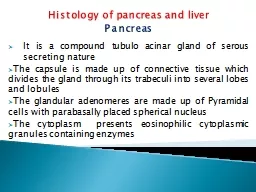

Pancreas It is a compound tubulo acinar gland of serous secreting nature The capsule is made up of connective tissue which divides the gland through its trabeculi into several lobes and lobules ID: 913470
Download Presentation The PPT/PDF document "Histology of pancreas and liver" is the property of its rightful owner. Permission is granted to download and print the materials on this web site for personal, non-commercial use only, and to display it on your personal computer provided you do not modify the materials and that you retain all copyright notices contained in the materials. By downloading content from our website, you accept the terms of this agreement.
Slide1
Histology of pancreas and liverPancreas
It is a compound
tubulo
acinar
gland of serous secreting nature
The capsule is made up of connective tissue which divides the gland through its
trabeculi
into several lobes and lobules
The glandular
adenomeres
are made up of Pyramidal cells with
parabasally
placed spherical nucleus
The cytoplasm presents
eosinophilic
cytoplasmic granules containing enzymes
Slide2The acinar cell rests over the basement membrane and the duct system presents
intercalated,intralobularduct,interlobular
duct,lobar duct and main excretory duct
The main excretory duct is lined with simple columnar epithelium
The central lumen of the
acini
presents
centroacinar
cells which are extended epithelial cells of intercalated ducts
Myoepithelial
cells are absent
Slide3Structure of pancreas
Slide4Islets of langerhan’s
of pancreas
Slide5Islets of Langerhan’s
Slide6Liver
Irregular connective tissue known as
Glisson’s
capsule is covered to its maximum extent by peritoneum
From this capsule the CT descends towards the center of the gland which are predominated with reticular fiber
These
septations
divide the parenchyma into roughly hexagonal lobules
The interlobular
septations
are quite prominent in pig and made up of collagen fibers and are least developed in other animals
Slide7Glisson”s capsule
Slide8Hepatic lobule
Slide9The interlobular septations around hepatic lobule form six angle out of which the three angles contain portal
vein,hepatic
artery and bile duct.These areas are called portal areas or portal canal
The cells of the liver are known as
hepatocytes
which are arranged in radiating columns from outer margin of central vein towards the periphery of the lobule
The hepatic cell column are separated from each other by sinusoids which start from periphery and opens in the central vein
The
hepatocytes
are usually
mononucleated
cells and nucleus is spherical and cytoplasm rich in
mitochondria,polyribosomes,ribosomes,lysosomes,SER,lipid
and glycogen granules
Slide10Portal triad
Slide11Hepatocytes
Slide12Sinusoids
Slide13The lining epithelium of sinusoids presents pores for transfer of macro and micro molecules of the nutrients carried through interlobular branch of portal vein
The sinusoidal wall is associated with large
stellate shaped phagocytic
cells popularly known as
Kuffer’s
cells
The space between the sinusoids and
hepatocyte
is called space of
Disse
Slide14Kuffer’s cell
Slide15Space of Disse